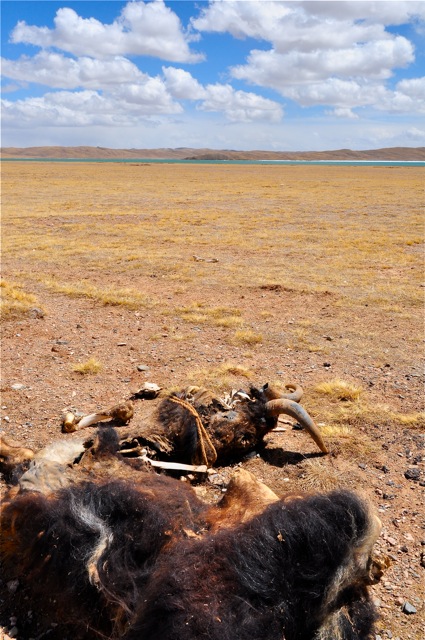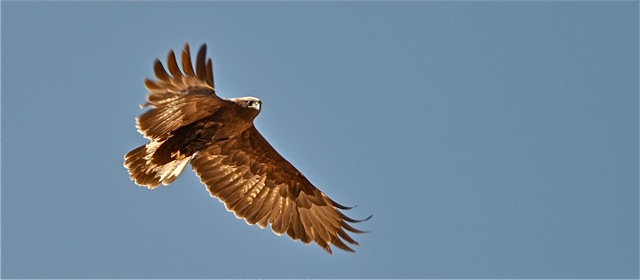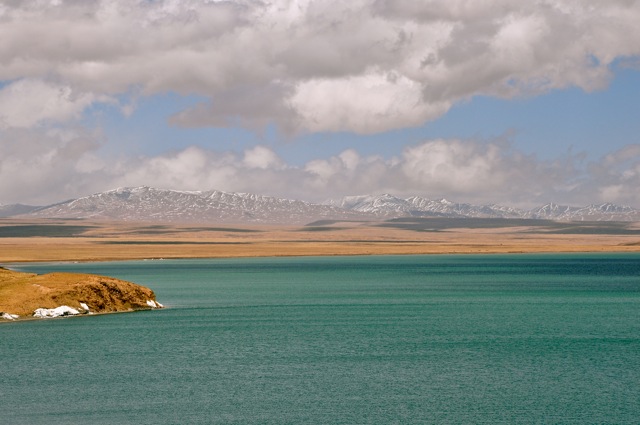At first it is a glimmer, nothing more than a reflection that I think might be there. Shimmering heat already ripples in the morning air blurring my sightlines. Michael’s eyes are creased studying the same spectre that I see…he is making a humming sound as if to speak and my veins are chocked with blood. Tsa (salt) and its ancient home are close and that sense is within both of us.
We are about 40 kilometres west of Mado in a remote but expansive valley and the vista before us refuses to clarify. We should be closing in on our long awaited salt mecca – the simultaneously famed yet hidden source of salt that drew in nomads from all over the plateau. The place to which goliath yak and weather-toughened men came and ultimately left, carting a hundred kilograms or more of pure white gold.
A bolt blue sky above is followed below by red earthen hills that run along the horizon and below these two known jolts of colour, a glimmering reflection continues to hover. What is stunning here is the absence of anything – as though all life, all moving things have been evacuated so that colour and space may play. We are at 4,300 metres and while the sun pounds down it is cold clear air that is running the show.
Suddenly all glimmering ends and there is in front of us a flat piece of glass and in those first seconds there is that rare feeling of certainty – we have arrived. Tsam Tso the Glorious – Tsam Tso, the utterly still.
The stillness has silenced our tongues and suppressed any grand displays. There are no demonstrations of success, no surges of happiness from either of us at having arrived – the stillness and emptiness is haunting.
“Few know of this place”, we have been told.
Above us a hawk (Nele) monitors our progress, its wings driving through the air, the only sound. For the past thirty years this high altitude lake has shimmered, but not hosted any salt seekers.
What we see is a shallow lake that is disappearing – we have been told that in the past ten years the water levels have declined dramatically. Quite what made the salt ‘better’ than other is a mystery but this salt was collected by traders from northwestern Sichuan making the two week journey, up to northern Qinghai and even to Lhasa in roughly a month.
A path to the north – a mere wisp – is what is left of the route which yak used to take their precious mineral cargoes to all points. One single nomadic tent remains. The family has been in the valley for generations and is the only remaining nomadic clan in view.
The family tells us how the lake itself will dry up in time. Thick salt coats the shallow lakes but is unused except by the odd bird that fancies a saline treat. Nomads left the valley when the famed salt dried up. When I ask what made the salt so special that traders traveled through such landscapes to access, the response was vague and simple – “because it was special salt”.
Silence pervades and the wind itself seems to be mindful that this is a valley of quiet – my mind wanders backward in time to when bodies came and went buying and trading for the salt. Traders from Sichuan would often bring special wood, sap and resin heavy pine for trade for salt – bartering has a deep and long running pedigree in these parts.
Two structures – salt storage facilities lie forlorn and dilapidated – lie just off of the shallows and saltpans.
Further on from our beloved and lonely Salt Lake two other bodies of water bid us welcome – the 1,000 square kilometre blue-green hulks of Gyoring Lake and its sister the Ngoring – which act as unofficial holding tanks for the second longest river in China, The Yellow River (Ma Chu in Tibetan). The origins of the Yellow River are further west, but my interest is in the pathways that line the lakes. It was here that salt caravans heading into Tibet camped, fueled up and departed south to Lhasa and Ngachu to deliver salt. Mules and horses, so preeminent upon the Tea Horse Road, were seldom used here. Yaks and their broad backs provided the platform for transportation. Very little remnants remain here of the route either, though a herd of Wild Tibetan Asses (known as Jiang) briefly gaze their soulful brown eyes at us.
We leave tomorrow for a portion of the most physical aspect of the route – a portion that deals both with the secular and the very earthy – one of the Himalayas most coveted mountains for Tibetans – Amne Machin/Amye Maqen. The plan is a seven-day circumambulation of the entire range. Perpetually snow clad, this sacred stone force pushes up almost 6,300 metres and was a rest/worshipping stop along the way for salt caravans.
Empty caravans making their way to the salt source of Tsam Tso would pass this massive body of stone and ice to pay respects.

A local expression about the fate of beings up here, "What falls is down". A yak corpse at 4500 metres.
Bags, tents, socks, tea and some suspect biscuits are being packed.
Until our return from the snow mountains, best from crystal air at 4,300 metres from us both.
Jeff











Congrats on finally reaching the Tsam Tso! What a wonderful opportunity to visit a place so rich in history, yet so abandoned in modern times.
I am not clear why no one travels there anymore. Perhaps you could explain why it has been abandoned by traders.
Thanks.
Best wishes,
Peter
Jeff;
Correct me if I am wrong seems this is the mountian that Joseph Rock wrote about in his book “The Amnye Ma-Chhen Range and Adjaacent Regions” I have a map and his book; seems same area? Enjoy your posts and photos.
You are entirely right – this is one and the same mountain. It was a ‘hot’ property long ago upon discovery but sadly much of the information nowadays is simply rehashed. The mountain itself is stunning and Michael and I often try and drift back to imagine what this place would have felt and seemed like in a time when many thought this the highest summit on the planet.
thanks for the note,
Jeff
Hi Jeff,
My grade 10 class is curious about the nomadic families. Emily asks how often do they move? How do they deal with the weather?
Continue to be careful,
Gen
At long last back to a place where the keyboard works. As to Emily’s question…the nomads may move up to a half-dozen times a year which is largely dictated by the grazing lands available to their yak, sheep and goats. With weather patterns changing the nomads must cope and rather than having a specific ‘date’ in mind for moving, they wait until there is a run of a few days of clement weather and temperatures and then….off they go en masse. They have long moved in a systematic pattern and intuitively do not over-graze. As for the weather they continue to stand by traditional wools as the yak and sheep provide wool that is warm, long-lasting and durable. In fact many nomads who have access to western Gortex and similar products often revert back to their wools as they are simply more conducive to the extreme conditions. The traditional black nomadic tents are also constructed from coarser strains of yak wool and are water, wind and odour proof….stunningly simple and effective material.
Hope you are all well. Postings will continue once again more regularly.
a very unshaved Jeff
Hi Gen,
I am sure Jeff will answer all questions when he is back in the land of technology. This will most likely be next monday. 5 more days to collect questions for him. I also want to know where they slept on the track now and if they have been the only people out there?
Borke
Pingback: Blog posts from Mei Zhang and others about China travel - WildChina